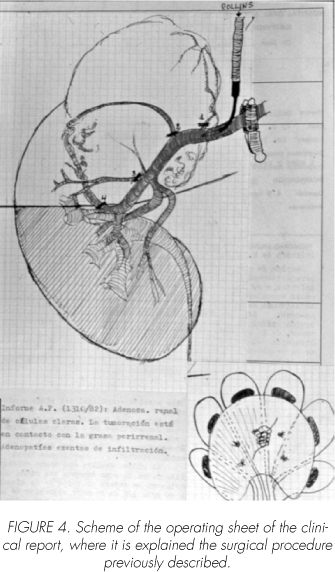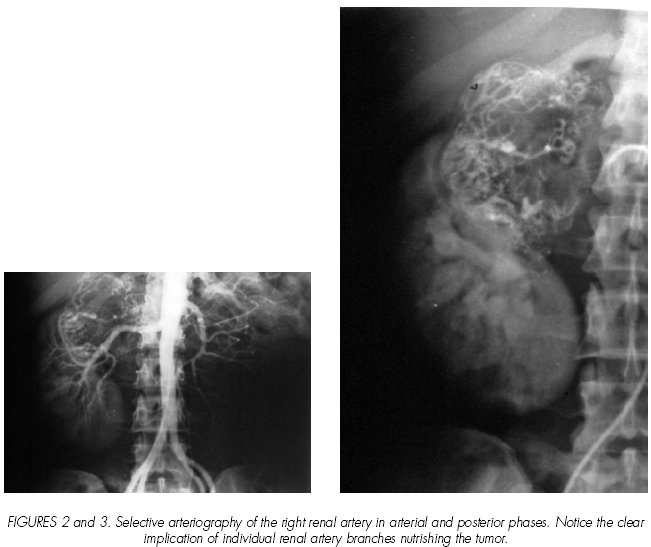Meu SciELO
Serviços Personalizados
Journal
Artigo
Indicadores
-
 Citado por SciELO
Citado por SciELO -
 Acessos
Acessos
Links relacionados
-
 Citado por Google
Citado por Google -
 Similares em
SciELO
Similares em
SciELO -
 Similares em Google
Similares em Google
Compartilhar
Archivos Españoles de Urología (Ed. impresa)
versão impressa ISSN 0004-0614
Arch. Esp. Urol. vol.62 no.4 Mai. 2009
Asynchronic bilateral renal cell carcinoma: Radical and in situ hypothermia nephron sparing surgeries
Carcinoma de células renales bilateral y asincrónico: Cirugías radical y conservadora con hipotermia in situ
Juan José Ballesteros Sampol and Albert Francés Comalat.
Urology and UQTR Department. IMAS Hospital. Barcelona. Spain.
SUMMARY
Objectives: To present the double action a urologist has to consider in front of a Renal cell carcinoma (RCC); on one hand, when the normality of the contralateral kidney is stated and, on the other hand when, forced by the existence of the tumor in a solitary kidney, it is mandatory to perform a surgical technique to preserve renal function.
Method: The case of a 43 year-old patient, diabetic who in 1982 underwent left radical nephrectomy for RCC diagnosed during a diagnostic work up for hypertension (HTA). Ten years later an upper pole renal tumor is found in the remaining kidney. Nephron-sparing surgery with in situ hypothermia was performed.
Results: The patient died 18 years after the first surgery and 8 years after the second. Death was due to diabetic decompensation, haemorrhage from a gastric ulcer and "retroperitoneal mass probably pancreatic" that was not characterized.
Conclusions: The PSA decline, the histology of the prostate during the adenomectomy and the morpho-metric changes after surgery and at mid-term, advise a more accurate value of PSA in patients who underwent open surgery, in order to detect a carcinoma in the residual prostate gland.
Key words: Bilateral Renal Cell Carcinoma. Hypothermia nephrone-sparing surgery. Surgery at solitary kidney.
RESUMEN
Objetivo: Presentar la doble actuación que se plantea frente a un Carcinoma de Células Renales (CCR), una vez cuando se constata la normalidad del riñón contralateral y, otra, cuando obligados por la existencia del tumor en riñón único, se debe recurrir a alguna técnica que preserve la función renal posterior.
Método: El caso de una paciente de 43 años, diabética que en 1982 sufrió nefrectomia radical izquierda por CCR diagnosticado al serle estudiada una HTA. Diez años más tarde se descubre tumor renal del hemirriñón superior derecho por el que se practicó cirugía conservadora con aplicación de "hipotermia in situ" para facilitar la heminefrectomía.
Resultado: A los 18 años de la primera cirugía y 8 de la segunda se produjo el fallecimiento de la paciente por descompensación diabética, hemorragias digestivas altas por ulcus gástrico y "masa retroperitoneal probablemente pancreática" que no se llegó a poder caracterizar.
Conclusiones: La hipotermia "in situ" supuso una excelente ayuda para la cirugía conservadora obligada en riñón único asiento de carcinoma de células renales con notable recuperación funcional total.
Palabras clave: Carcinoma renal bilateral. Cirugía renal bajo hipotermia. Cirugía en riñón único.
Introduction
Bilaterality is a recognized fact that it reaches between the 0,4% to 5% of renal cell carcinomas (RCC) corresponding the greater frequency to diseases as Von Hippel Lindau, familiar renal cell carcinoma, acquired quistic disease post dialysis or Birt-Hogg-Dube syndrome. Radical nephrectomy continues being the therapeutic attitude against RCC in cases with normal contralateral kidney. Nevertheless, there are more and more evidences that nephronesparing surgery in tumors with size inferior to 5 cms of diameter, can reach comparable survival to the radical surgery. Furthermore, series of nephrone-sparing surgery (opened or laparoscopic) in larger tumors have been described lately (1,2).
When the circumstance of a RCC in a solitary kidney appears, two are the options that can be adopted: either radical nephrectomy and inclusion of the patient in dialysis program, or nephrone-sparing surgery leaving a percentage of funcionating kidney enough to maintain the homeostasis. The success of this second option will be basically conditionated by the tumor size, as well as its location within the organ and its dependency of the intrarenal circulation. It will be prudent, therefore, to be able to make some kind of preoperative study of this vascular architecture that allows us to plan the strategy to follow during the surgery. When this surgery is done without having an exact vascular map or the tumoral heterogenicity invades irregularly the vascular territories, it is necessary to "guillotine" equatorially the organ with the consequent risk of haemorrhages and/or fistulas in the post-operative period. At this background it is going to have a decisive importance the time of ischemia that we need to finish this surgery.
Clinical report
We present the case of a 43 years old woman with antecedents of diabetes diagnosed two years before and in treatment with hypoglicemic oral treatment. She was also diagnosed of hypertension, initiating a study that include an intravenous urography (IVU) that demonstrated a renal mass in the left kidney. It was also done an angiography (Figure 1) that showed a mass of 10 cms that occupied the mesorenal and hilium areas with an arteriovenous fistula that caused a great vascular pseudoaneurisma. At venous phase of the exploration a remarkable expansion of the exorenal vascularization was observed. With the evidence of a normal contralateral kidney, it was performed a left radical nephrectomy with reduced lymphadenectomy of renal and paraaortic lymph nodes. The patological study showed a 9 cms clear cells RCC, with solid growth and granulomatous areas. The adenopathies were negative only presenting sinusal histiocitosis.

The patient remained asymptomatic until an ultrasound exploration, in 1982, when an upper-pole mass is discovered in the remaining kidney. Already thinking about the necessity to perform a nephronesparing surgery, a complete angiographic study of the vascular architecture of the organ was asked for (Figures 2 and 3). It allowed us to see as the tumor received two direct arterial branches from the renal one, very extrasinusals and other two that irrigated the healthy renal parenchyma that limited the tumor and that we should sacrifice to perform a correct oncological surgical procedure. At 7.07.82 we performed, under hypothermia in situ and vascular perfusion with Collins, the dissection of the renal artery with tie of those four branches already programmed on the renal vascularization (Figure 4). The pathological anatomy report was of 6,5 cms clear cells RCC in contact with the perirenal fat tissue and negative lymph nodes. Within the following years the patient entered Internal Medicine (IM) by successive diabetic decompensations being useful to maintain control of his renal pathology by the realization of CT scans that were normal. In a last re-entry in IM by bleeding secondary to an haemorrhage due to a gastric ulcus and lost of weight, it was seen by CT scan a pancreatic retroperitoneal mass. It was not possible to find out the origin of that mause cause of the death of the patient, 18 and 8 years after her respective renal surgeries.

Comments
It is evident that the present case did not pose any doubt in the conduct to follow when the first tumor of the left kidney was found: With a normal contralateral kidney, radical nephrectomy. Years later the situation is different with a tumor in a solitary kidney and, therefore, the indication of forced nephrone-sparing surgery. In such circumstance also it is clear that we must remove the tumor with bordering healthy renal parenchyma following the oncological principles and that allows a careful haemostasia that avoids the nonrare complications (4) of haemorrhages and fistulas. For getting that we must control the vascular pedicle.
There are opinions in favor of total clamping of the artery and the vein or only arterial clamping. Such cases depend on the "tolerables" time of ischemia. For that reason they are usually attitudes adopted against tumors of smaller diameter and more peripheral situation. Theorically the ischemia time in normotermia must not go beyond the 30 minutes (5). In the present case, the vascular study lead us to a careful dissection of the branches of the renal artery with the idea to bind those that nourished the tumor.
As such attitude could force us to extend the surgical time we used the hypothermia in situ with perfusión of Collins liquid (method often used at surgery of kidney transplantation as well as of extracorporea renal surgery) (3) completing the circuit with the clamping and opening of an eyelet in the renal vein (See scheme of the operating sheet in figure 4). It allowed us a careful dissection extending the ischemia in hypothermia until 45' with total functional recovery (Creatinine 0,8 mg/dL to the discharge). In addition it favored the haemostatic stitches given in areas barely provided of arteries by the previous bindings. By all this we think that the study of the vascular architecture of the tumor and the application of hypothermia allowed us to very concretely select the individualized positioning of the bindings and without the pressure time that supposes to work on an ischaemic organ in normotermia, in selected cases. The excellent renal function to the discharge (creatinine 0,8 mg/dL) is a clear exponent of the minim or null aggression on the remaining functioning renal tissue.
Conclusions
A prospective study is necessary to analize two groups of patients undergoing prostate adenomectomy, one with a corrected cutt-off PSA -in close relation with the PSA density-, to indicate an appropriate biopsy and see its correlation with cancer detection rate. Obviously, the assessment findings will be related to patient's age, in order to consider a real benefit to the patient.
 Correspondence:
Correspondence:
Juan J.Ballesteros Sampol
Bori y Fontestá, 43 8o 2o
08017 Barcelona. (Spain)
jballesteros@imas.imim.es
Accepted for publication: May 9th, 2008.
References and recommended readings (*of special interest, **of outstanding interest)
*1. Novick A C, Streem S, Montie J E, Pontes JE, et al. Conservative surgery for renal cell carcinoma: a single center experience with 100 patients". J.Urol., 1989; 141, 835-839. [ Links ]
*2. Gill S. Laparoscopic surgery for renal cell carcinoma en: Operative Urology at the Cleveland Clinic. Humana Press Inc. Totowa, New Jersey.USA (2006) pags. 51-63. [ Links ]
3. Collins G M, Bravo-Shugarman M y Terasaki P I. Kidney preservation for transportation. Inicial perfusion and 30 hours ice storage. Lancet, 1969; 2, 1219-1221. [ Links ]
*4. Van Poppel H, Claes H, Willemen P, Oyen R, et al. Is there a place for conservative surgery in the treatment of renal carcinoma?" Brit J Urol., 1991; 67, 129-133. [ Links ]
5. Serrallach Milá N, Aguiló Lucía F, Condom E, Franco Miranda E, et al. Cirugía conservadora en el carcinoma renal. Annals d'Urologia, 1997; 1(3): 187-204. [ Links ]











 texto em
texto em 



